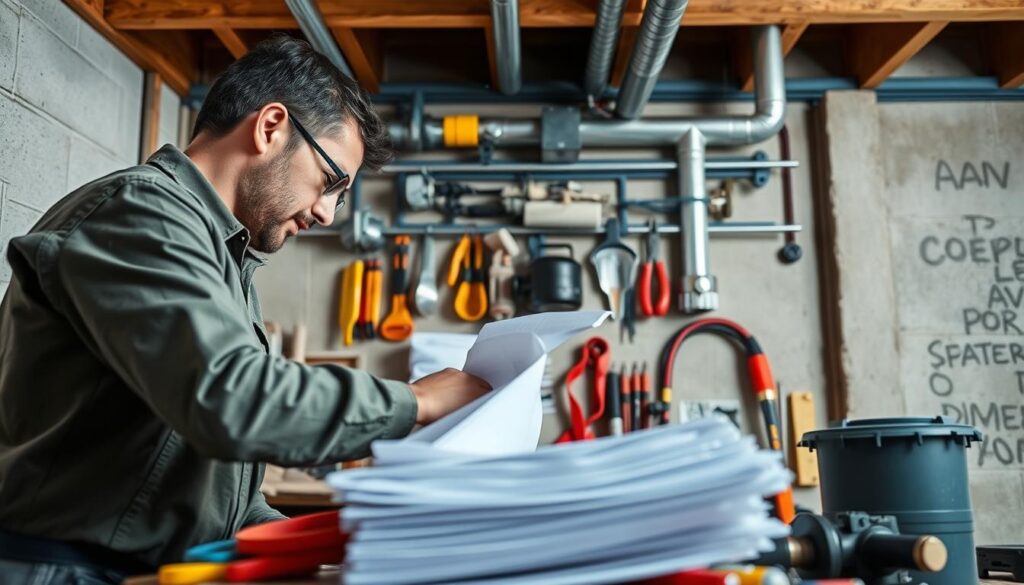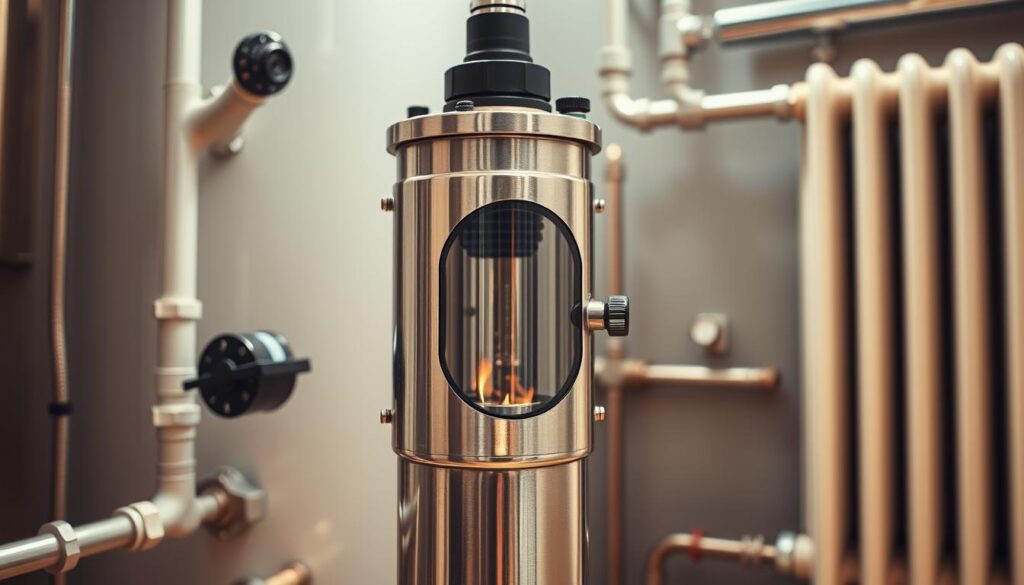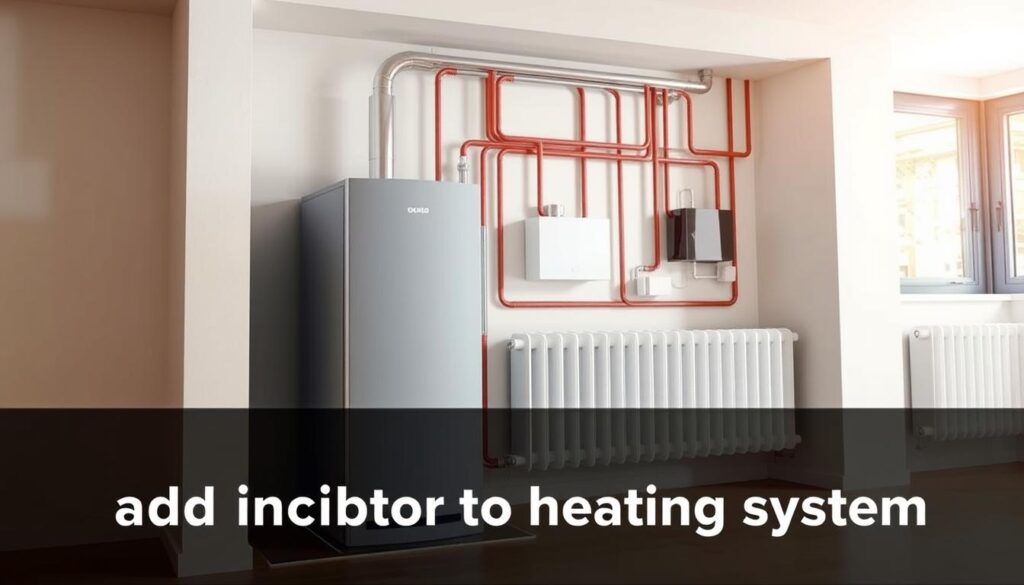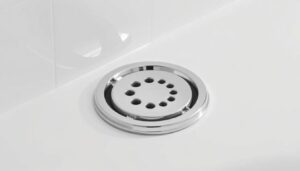Are you aware of the silent guardian that keeps your heating system running smoothly? It’s not the boiler, nor the radiators, but something that works behind the scenes to prevent disasters. Most people aren’t sure what this crucial component is or how it functions.
A central heating inhibitor is a vital element that protects your heating system from common issues like sludge buildup and corrosion. Without it, your system’s health is at risk, and your warranty could be invalid.
Key Takeaways
- Understand the role of a central heating inhibitor in maintaining your system’s health.
- Learn how to identify the correct inhibitor levels for your heating system.
- Discover the step-by-step process for adding inhibitor to different types of heating systems.
- Find out how to extend your boiler’s lifespan and improve heating efficiency.
- Recognise the importance of safety precautions when adding inhibitor to your system.
What is Central Heating Inhibitor?
Central heating inhibitors are chemical liquids that play a vital role in safeguarding your heating system’s integrity. They are designed to protect the internal components of your central heating system from corrosion, scale buildup, and sludge formation.
Chemical Composition and Function
The chemical composition of a central heating inhibitor typically includes a mixture of potassium tetraborate tetrahydrate, disodium molybdate, sodium nitrate, and other compounds. These chemicals work together to create a protective barrier on metal surfaces, neutralising acids and maintaining optimal pH levels to prevent corrosion in radiators and pipes.
Types of Inhibitors Available
There are several types of inhibitors available, including general-purpose inhibitors for mixed-metal systems, specialist formulations for aluminium components, and combined inhibitor-cleaners. Leading brands such as Sentinel X100, MagnaClean MC1, and Fernox F1 offer slightly different formulations but all provide essential protection for your central heating system.
Why Adding Inhibitor to Your Heating System is Essential
To maintain your heating system’s performance, adding inhibitor is not just recommended, it’s essential. The chemicals in the inhibitor work together to break down the sludge in your central heating system and protect it from building up again.
Protection Against Corrosion and Sludge
Without proper inhibitor protection, your system becomes vulnerable to corrosion as water constantly flows through metal components, creating rust and sludge that can block pipes and radiators.
Improving System Efficiency
Properly treated systems maintain better heat transfer efficiency, ensuring your radiators heat up quickly and evenly while reducing energy consumption by up to 15%.
Extending Boiler and Radiator Lifespan
Using inhibitor can extend the lifespan of expensive components like your boiler and radiators, potentially adding years to their operational life and saving you from premature replacement costs.
- Adding inhibitor prevents costly damage over time.
- It reduces the risk of corrosion and sludge buildup.
- Improves heating efficiency, lowering energy bills.
Signs Your Heating System Needs Inhibitor
It’s essential to monitor your central heating system for signs that suggest it requires additional inhibitor. Recognising these signs can help prevent damage and maintain efficiency.
Cold Spots on Radiators
Cold spots, particularly at the bottom of radiators, indicate sludge buildup due to insufficient inhibitor protection. This issue can lead to reduced heating performance in your home.
Reduced Heating Efficiency
If your radiators are taking longer to heat up or some rooms are colder than others, your heating system likely needs more inhibitor. This can impact overall heating efficiency.
Noisy System Operation
Unusual noises like gurgling, banging, or kettling sounds from your heating system can indicate scale buildup or trapped air, issues that proper inhibitor use can help prevent, ensuring smoother operation over time.

Tools and Materials You’ll Need

To ensure a smooth process, you’ll need to prepare the right tools and materials for adding inhibitor to your heating system. This will make the process much more effective and help you avoid potential issues.
Recommended Inhibitor Products
For inhibitor products, consider trusted brands like Sentinel X100, MagnaClean MC1, or Fernox F1—each offering reliable protection for domestic heating systems with slightly different formulations.
Essential Tools for the Job
You’ll need a bottle of inhibitor appropriate for your system size (typically 500ml for systems with up to 10 radiators, or 1 litre for larger systems). Essential tools include a radiator bleed key, adjustable spanner, towels or cloths for catching drips, a funnel with flexible tube or a proper inhibitor injection tool, and a container to catch any water drained from the system. For some systems, you might also need a pressure gauge to check and adjust your boiler pressure after adding the inhibitor, as well as protective gloves to prevent skin contact with the chemicals.
Preparation Steps Before Adding Inhibitor
To ensure a smooth process, several preparation steps must be taken before adding inhibitor to your heating system. Proper preparation is essential for both your safety and the effectiveness of the process.
Turning Off Your Heating System
Always begin by turning off your heating system completely and allowing it to cool down. Attempting to work on a hot system can result in serious burns from escaping water or steam. Make sure you let the radiators cool down completely before proceeding.
Safety Precautions to Take
Gather all necessary tools and materials before starting. Lay down towels or protective coverings around the area where you’ll be working to catch any potential spills or leaks. It’s also crucial to read the manufacturer’s instructions on your chosen inhibitor product carefully.
Checking System Pressure
Check your boiler’s current pressure reading and make a note of it. The ideal pressure is typically between 1-1.5 bar for most systems. You’ll need to return to this level after adding the inhibitor.
| Preparation Step | Description |
|---|---|
| Turn off heating system | Completely switch off and let cool |
| Safety precautions | Gather tools, lay protective coverings |
| Check system pressure | Note current pressure reading |
How to Add Inhibitor to a Combi Boiler System
Maintaining your combi boiler with inhibitor is key to its optimal performance and durability. Adding inhibitor to your combi boiler system is a straightforward process that requires some basic steps.
Step 1: Locating the Radiator Bleed Valve
First, you need to locate an accessible radiator bleed valve, preferably on an upstairs radiator to aid system circulation. Use a spanner to remove the bleed plug.
Step 2: Draining Some Water from the System
Turn off your heating system and let it cool completely. Then, partially drain the system by opening the radiator valve and collecting the water in a suitable container. This creates space for the inhibitor.
Step 3: Adding the Inhibitor Through the Radiator
With the bleed valve open, attach the manufacturer’s dosing adaptor or a funnel with a flexible tube to the opening. Slowly pour the inhibitor into the radiator; typically, one 500ml bottle is sufficient for systems with up to 10 radiators.
Step 4: Restarting Your System
Once the inhibitor is added, replace and tighten the bleed valve, turn the radiator valves back on, and check your boiler pressure. Bleed all radiators to remove any trapped air before restarting your heating system.
By following these steps, you can effectively add inhibitor to your combi boiler system, ensuring it remains protected against corrosion and sludge buildup.
- Locate an accessible radiator bleed valve and remove the bleed plug.
- Drain some water from the system to create space for the inhibitor.
- Add the inhibitor through the radiator using a dosing adaptor or funnel.
- Restart your system, checking boiler pressure and bleeding radiators as needed.
Adding Inhibitor to a Conventional Boiler System
Unlike combi boilers, conventional boiler systems have a different method for adding inhibitor, primarily through the feed and expansion tank. This process is crucial for maintaining the health and efficiency of your central heating system.
Using the Feed and Expansion Tank Method
To add inhibitor via the feed and expansion tank, first, ensure the water supply to the tank is turned off. Then, drain some water from the system to create space for the inhibitor. Inspect the tank for any signs of corrosion or debris and clean it if necessary. Pour the recommended amount of inhibitor directly into the tank, typically one 500ml bottle for systems with up to 10 radiators. Once the inhibitor is added, switch the water supply back on to refill the system.
Alternative Methods for Conventional Systems
For systems without accessible feed tanks, alternative methods can be employed. If your system has a magnaclean filter installed, you can remove the magnet and housing and pour the inhibitor directly into the filter body. Another option is using a specially designed inhibitor injection tool connected to a radiator valve. These methods ensure that your conventional boiler system receives the necessary protection against corrosion and sludge.
| Method | Description | Applicability |
|---|---|---|
| Feed and Expansion Tank | Pour inhibitor into the feed and expansion tank after draining some water from the system. | Systems with accessible feed and expansion tanks. |
| Magnaclean Filter Method | Pour inhibitor into the magnaclean filter body after removing the magnet and housing. | Systems with a magnaclean filter installed. |
| Inhibitor Injection Tool | Use a specially designed tool connected to a radiator valve to inject inhibitor into the system. | Systems without accessible feed tanks. |

How Much Inhibitor to Add to Your Heating System
The right amount of inhibitor is essential for maintaining a healthy heating system. When adding inhibitor, it’s crucial to follow the manufacturer’s guidelines to ensure you’re using the correct amount for your system’s size and configuration.
Calculating the Correct Amount
To determine the correct amount of inhibitor, consider the size of your heating system, including the number of radiators and the water capacity. Typically, a domestic heating system requires one 500ml bottle of inhibitor for systems with up to 10 radiators or approximately 100 litres of water capacity. For larger systems, you may need more. Always check the manufacturer’s instructions, as concentration levels can vary.
| System Size (Radiators) | Water Capacity (Litres) | Inhibitor Amount |
|---|---|---|
| Up to 10 | Up to 100 | 1 x 500ml bottle |
| More than 10 | More than 100 | 2 x 500ml bottles |
Can You Add Too Much Inhibitor?
Interestingly, you cannot add too much inhibitor to your central heating system. Excess inhibitor will not cause damage but will instead provide additional protection. This means that if you’re unsure, it’s better to err on the side of caution and add a bit more, following the manufacturer’s guidelines.
Common Mistakes to Avoid When Adding Inhibitor
The key to successfully adding inhibitor to your heating system lies in avoiding common mistakes that can compromise its performance and longevity. When you add inhibitor to your system, you are taking a crucial step in protecting your central heating system from corrosion and sludge.
Mixing Different Brands of Inhibitors
One frequent error is mixing different brands of inhibitors in the same system. While not typically dangerous, different formulations may react unpredictably or reduce overall effectiveness. It is recommended to use the same brand of inhibitor to prevent any lowering in efficiency and reactions to your system.
Insufficient System Draining
Insufficient system draining is another common mistake. If you don’t create enough space in the system by draining some water first, the inhibitor may not circulate properly or might overflow when added. Ensuring adequate draining is crucial for the effective distribution of the inhibitor throughout your heating system.
Forgetting to Bleed Radiators Afterwards
Many people forget to bleed their radiators after adding inhibitor, which can lead to air locks that prevent proper circulation of both the heating water and the newly added inhibitor throughout the system. Bleeding your radiators is a simple step that ensures your system operates efficiently.
| Common Mistake | Consequence | Prevention |
|---|---|---|
| Mixing Different Brands | Reduced Effectiveness | Use Same Brand |
| Insufficient Draining | Overflow or Poor Circulation | Drain System Adequately |
| Not Bleeding Radiators | Air Locks | Bleed Radiators |
Maintenance Schedule: How Often to Add Inhibitor
Maintaining the appropriate level of inhibitor in your central heating system is essential for preventing damage and ensuring it operates efficiently. A regular maintenance schedule helps in achieving this goal.
Recommended Timeframes for Inhibitor Replacement
You should typically add inhibitor to your central heating system every one to two years. During your annual boiler service, your heating engineer should test the system and add inhibitor as necessary. The inhibitor’s effectiveness dilutes over time, typically lasting around a year, after which it may not provide sufficient protection against sludge, limescale, and rust.
| System Condition | Recommended Inhibitor Replacement Frequency |
|---|---|
| Normal Operating Conditions | Every 12-24 months |
| After Significant System Work (e.g., Power Flushing) | Immediately after work is completed |
| Frequent Boiler Pressure Top-ups Due to Leaks | After every top-up, or during annual service |
Signs It’s Time for a Top-up
If you notice radiators taking longer to heat up, cold spots developing, unusual noises from the boiler or pipes, or a decline in heating efficiency, it may be time to add more inhibitor. You can also use a central heating inhibitor test kit to check the concentration of inhibitor in your system.
Key indicators for adding more inhibitor include: recent system draining or refilling, frequent pressure top-ups due to leaks, and signs of reduced system performance.
Conclusion: Ensuring Long-term Protection for Your Heating System
The importance of adding inhibitor to your heating system cannot be overstated, as it protects against corrosion and maintains efficiency. By incorporating a quality central heating inhibitor, you can prevent the three major enemies of heating systems—corrosion, sludge buildup, and limescale.
Regular maintenance with inhibitor not only prolongs the lifespan of your boiler and radiators but also ensures your system operates smoothly, saving you money on maintenance costs and repairs. Additionally, maintaining proper inhibitor levels helps validate your boiler warranty.
To further enhance your system’s protection, consider installing a magnetic filter to capture metal particles and a scale reducer in hard water areas. If you’re unsure about adding inhibitor yourself, don’t hesitate to contact a Gas Safe registered engineer to perform the task professionally.



